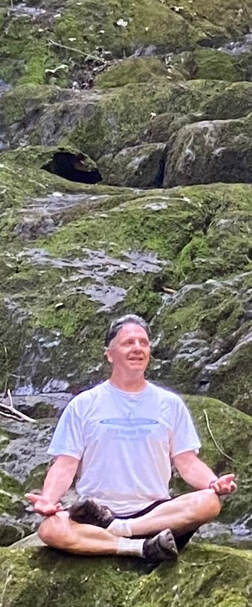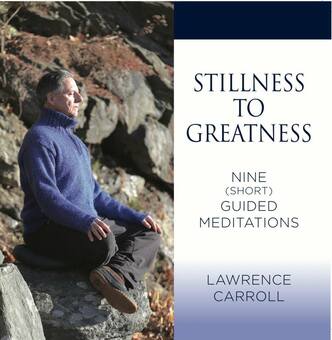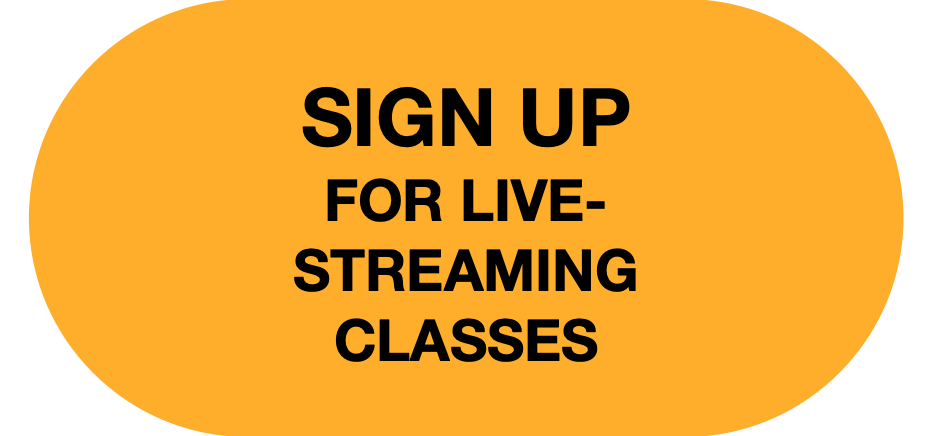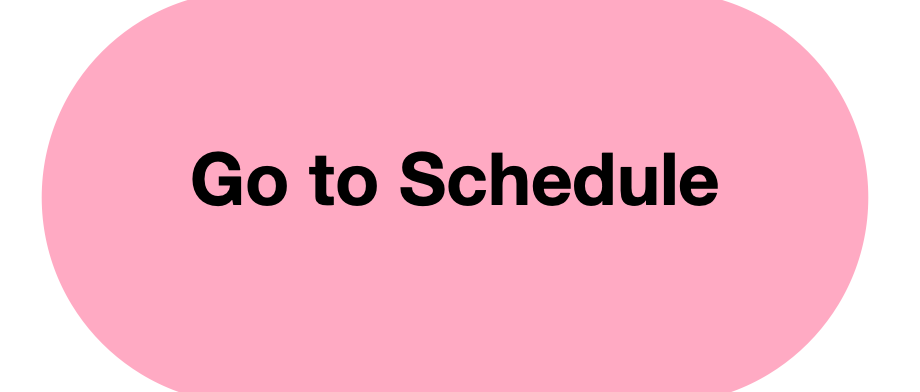 I am currently teaching meditation to hundreds of people every year. I teach in a number of places including Canyon Ranch Spa, The Graduate Institute, Columbia University, the YMCA and several yoga studios. My background in meditation spans over three decades. My first experience of meditation was to support my first wife. She was dying of a brain tumor and used meditation as a tool to manage pain. I had no idea what I was doing. I would sit beside her in an uncomfortable position, forcing myself to sit in lotus for an hour at a time, ankles aching. From this torturous time I learned:
My wife left me before she died. I went into a deep depression. My world view was shattered. Everything that had meaning and brought me happiness seemed superficial and empty. I sought answers to my pain and confusion. Over the next thirty years I found myself in the company of powerful teachers such as Dhirivamsa, Osho Rajneesh, Teertha, H.W. L. Poonja and Andrew Cohen. Each teacher gave me new insights into the nature of life. Each contributed to my understanding of meditation. Each one gave me a clue to the puzzle of life I was trying to solve. Dhirivamsa revealed meditation is not a particular experience. I was on a three day meditation retreat with him in Western Australia. We were sitting for ten hours a day. More than I had ever sat at anytime. At one point a woman excitedly described her experience to Dhirivamsa. She said she could see colorful lights exploding in her mind’s eye. He admonished her and said she was not meditating and to keep still. He looked at me and said “you are a good sitter.” Thirty years later I would understand what he meant. Osho Rajneesh made it clear to me and tens of thousands of others that meditation may take radical, sometimes powerfully cathartic actions to see beyond the powerful fluctuations of the mind. Teertha revealed the commitment to meditation is a commitment to living life in a new way. Poonja could humorously make light of thought, to the point I would feel a deep ecstatic joy in his company. Cohen distilled everything into a comprehensive and intellectual theory. Reminding me that theory before experience is meaningless. Theory after experience is obvious. Finally I trained at the Kripalu School of Yoga and found new devices to help me teach others what I had discovered over thirty years - that we are always, already meditating. So how do I teach meditation? I start by saying “we are already meditating. We relax to meditate not meditate to relax.” I like to use the eye of a hurricane as a metaphor for meditation. A hurricane’s powerful winds twirl about a still center. Without that still center the hurricane would have no integrity. It would not exist. The closer we come to the center of the hurricane the winds calm down and become quiet. So it is with meditation. The winds are metaphors for the whirling thoughts and emotions. Like a hurricane we have a still, quiet center from where we witness everything. Max Piccard, the twentieth century philosopher said a man who has lost silence has lost his very structure. Meditation is remembering that silence within. It is the recognition of an integral part of our totality, our structure. I offer seven buoys to help those in the class experience meditation. By focusing their attention on any or all of these buoys the class becomes very still and quiet. P = Posture. Good posture is essential to be comfortable and alert. The original science of yoga was dedicated to postural alignment in order to aid practitioners to meditate. S = Smile. On a long retreat in the Berkshires (10 days of meditating for up to seven hours a day) I discovered that smiling was a powerful way to yoke in my mind. A simple slight Mona Lisa smile fractures the mind’s habitual tendency to dwell on the idea "something is wrong." B = Breath. Focusing on the four parts of the breath gives the mind something to notice that is happening in this moment. The four parts of the breath are the inhale, exhale, and two turning points between the exhalations and inhalations. Some schools of meditation such as Vipassana make this the sole focus of attention. Yoga has introduced many breath techniques in order to help the mind stay focused or balanced. R = Relax. The body is like the canary in the coal mine. The unconscious movement of thought will tense the body. Finding areas of tension in the body, gross or subtle, means you can use the breath and mind to soften and relax these areas. Relaxing the body, over time, will relax the automatic reactions of tension to thoughts arising in the mind. Relaxation will support you to be alert in order to notice the phenomena of ever-present meditation. F= Feel. Many Zen meditations focus on simple physical feelings. Feeling is another in the moment experience. Examples include feeling: the surface of the foot on the ground; your sit bones on a chair; the air against your skin, the movement of your breath in and out of the body. As you become more attuned and sensitive you may feel more subtle feelings such as your heart beat. If you feel subtle tensions you can apply the other buoys such as Relax, Posture, Smile and Breath to help ease the tension. N = Notice. Notice what it is you have not yet noticed. Perhaps it is sounds you can hear around you. Let the sounds come, drift and go (similar to Mindfulness techniques). Perhaps you notice the sound of your own breath. Then you may notice the inner sounds - thoughts. Let the thoughts be like little birds flitting between branches. Watching thoughts come and go is like coming into the center of the hurricane and noticing the whirling winds in the distance. The goal is not to stop thought but to notice the way thought comes and goes. A = Allow. Allow or Permit your experience to be as it is, without judgment. In the end this is both the path and goal of meditation. The source of all tension is the non-acceptance of your experience. Practicing letting everything be as it is is the taste of witnessing free from wanting something in particular. This freedom from wanting something (or not wanting something) is meditation. It is both a practice and a way of living. It is the arising of what yoga calls Santosha or contentment. I have discovered it is my natural state and that state is free of worry or anxiety. More so it is the source of a non-material blissfulness. Finally I like to remind myself and others that to approach meditation with any presumptions of how it should or should not be will prevent you stumbling upon the truth - you are already meditating. I introduce meditation to such diverse groups as police, lawyers, teachers, senior citizens and young children. For public talks, events, workshops and coaching contact me below for more information.
0 Comments
Leave a Reply. |
Become a PatronSign up and get free membership, access to yoga class video library, Laurie's schedule details and blogs.
Why Do Yoga at Home?Since Covid-19 several of my clients have discovered that doing live-stream yoga is: Archives
January 2024
more blogs |
Products |
Telephone(413) 212-2030
|
Contact |




 RSS Feed
RSS Feed
